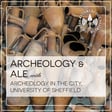
Half Pint: Lodge Moor POW Camp with Bob Johnston - Ep 31
Archaeology and Ale is a monthly series of talks presented by Archaeology in the City, part of the University of Sheffield Archaeology Department’s outreach programme. In this episode, we introduce Half Pint. The short interview-style format which we will be undertaking during the COVID-19 lockdown. For our first Half Pint, we are happy to welcome Dr Bob Johnston from the University of Sheffield speaking about his work on the Lodge Moor POW camp in Sheffield. Bob is a senior lecturer of landscape archaeology at Sheffield's department of archaeology. His work focuses on the archaeology of Bronze Age Britain and Ireland. While being one of the researchers in charge of the ongoing work at the Lodge Moor site in Sheffield Bob is also involved in several public archaeology and heritage projects. For more information on Bob and on the Lodge Moor project please follow the links below.
For more information about Archaeology in the City’s events and opportunities to get involved, please email archaeologyinthecity@sheffield.ac.uk or visit our website at archinthecity.wordpress.com. You can also find us on Twitter (@archinthecity), Instagram (@archaeointhecity), or Facebook (@archinthecity)
Affiliates
